“TM opened a lot of doors for healing and self-discovery, allowing me to sense an inner stillness and light.” —Anjali Nayar, TM scholarship recipient
In this season of light, giving, and miracles, we bring you the stories of three people whose lives were changed for the better with the gift of learning the Transcendental Meditation® (TM®) technique in a time of need. Thanks to generous donations from fellow meditators locally and across the country, they were able to receive a TM scholarship and create new futures for themselves.
Learning and practicing TM has helped all three move beyond the consequences of trauma and undertake new dreams and possibilities. As Tom Rudderow writes, “TM has not just helped heal my PTSD; it has helped me find the true spirituality I’ve long sought.”
At TM Centers across the United States, scholarship funds guarantee that anyone wanting to learn TM can, no matter their circumstances. Donations are made through TMFriends.org, the charitable arm of the U.S. non-profit organization teaching the TM program, and 100 percent of contributions are used for scholarships. This national initiative has raised $7 million over eight years, and over 7,000 people have learned the TM technique with local scholarships.

To make a tax-deductible donation for your local TM Scholarship Fund, or to a national program for people at risk, visit TMFriends.org
Cora Cee reflects that practicing TM has become “such a fundamental, core part of every aspect of who I am uncovering, I don’t really know yet how to begin to tell my story.” Now Cora, Tom, and Anjali are giving back by sharing their stories of healing and self-discovery with all of us.
Cora Cee, Yoga Instructor and Barista
Sheridan, Wyoming
Nine years ago Cora Cee’s life took a sharp left turn. The Wyoming native had been on a normal track—leaving home in Sheridan for college in Missoula, Montana, then law school and graduate school in Tucson, Arizona—when fate struck.
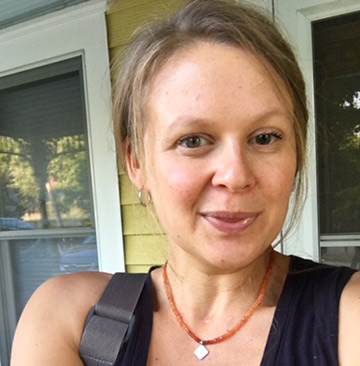
Cora Cee, at home in Sheridan, Wyoming
“I was riding my bike in town in Tucson and wasn’t wearing a helmet. A driver turned and didn’t see me—the sun was in her eyes—and she hit me,” Cora recalls as she talks with me by phone from Sheridan, where she lives again. “I suffered a severe traumatic brain injury and was knocked into a coma for two weeks. It was horrible for my family. I slept through it, of course, but the recovery has been very difficult.”
Then, in March of 2016, a friend from Cora’s yoga teacher training in Billings, Montana, where she moved after the accident, told her about the TM technique. Excited to learn more, Cora went to an introductory talk in Billings with Roger Kirk, director of Montana’s Bozeman TM Center. But she doubted her brain could do TM.
“It would have been cool before I was in an accident, but I probably can’t do it anymore,” she remembers thinking.
She was about to sneak out of the talk, when Roger asked if she had any questions. Cora expressed her concerns, and he explained that as long as people can think, they can practice TM. She was encouraged, but couldn’t afford the course fee on her day-care-center wages, so Roger offered her a TM scholarship.
“I remain so grateful that Roger chose to give me a scholarship,” she says. “I absolutely could not have started TM without one, then or now.”
“Meditating helps me accept what is, not what and how I ‘should’ be. It reminds me to soak up the incredible magic I am a part of, now and always.” —Cora Cee
Cora began her TM training the next day. “I was still very worried that I wouldn’t be able to meditate. My traumatic brain injury, or TBI, affects my memory, it affects my vision, it affects so many things about me,” she says.
But her first meditation “was amazing,” Cora remembers. “It was astonishing to me that I could experience something like that. It’s mind-blowing, when you first drop into that space.”
Cora has been practicing TM ever since, and it has been “exponentially more than what I sought. It’s automatic. I can feel my brain switching gears. And it continues to benefit my life tremendously, every day, and on so many levels—in healing from my TBI and continuing to grow into the person I am. I feel TM has been more healing than anything else.”

Cora Cee, enjoying the summer of 2018
Practicing TM has also helped Cora move beyond the accident. “Meditating helps me accept what is, not what and how I ‘should’ be. It reminds me to soak up the incredible magic I am a part of, now and always,” she says, mentioning a recent insight. “Sure, I have double vision. Yeah, my eyes look different. But I can see, and look at the changing fall colors. I’m not blind! It’s another one of the epiphanies that happens because of meditation, that I carry with me always.”
Cora has also noticed big changes in her interactions with the world. For the last eight years she hadn’t let family and friends take photos of her, because she was self-conscious about her lazy eye resulting from nerve damage. “But now I feel so much better and genuinely smile at cameras again. I had a wonderful summer, so we got lots of good pictures,” she says.
As we prepare to say good-bye, Cora again says, “I am so grateful for having learned how to do this. Practicing TM is one of the best parts of my life.”
“I am so grateful for having learned how to do this. Practicing TM is one of the best parts of my life.” —Cora Cee
Tom Rudderow, Advocate for Forgiveness
Oakland, California
One night in 2006, four young men approached Tom Rudderow on an Oakland street, looking for money to purchase alcohol and marijuana. “I’m sorry we have to do this,” one of them said. Then they attacked Tom, kicking him in the head repeatedly and leaving him for dead.
Three days later he woke from the coma no one was certain he’d survive. “A friend who was sitting by my bed said I suddenly sat up and said, ‘James, I gotta forgive these guys. How do I do that?’ Then I fell back asleep,” Tom recalls in our email correspondence. “When I woke again it was done. I’ve never experienced a moment of anger or vengeance—only concern, compassion, curiosity.”
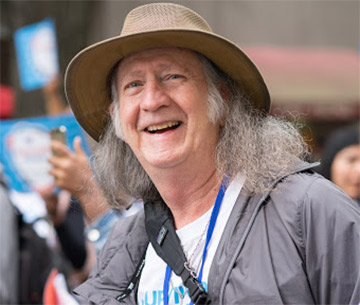
Tom Rudderow, at the Crime Survivors for Safety and Justice march in Sacramento, California, April 2018
So began Tom’s journey with traumatic brain injury (TBI), post-traumatic stress disorder (PTSD), and becoming an advocate for forgiveness. Along the way he learned the TM technique, which he considers one of the many positives resulting from the attack. But first he needed to come to terms with his assaulter.
In 2012, Tom discovered Victim Offender Dialogue, a government-sponsored, professionally guided process in which victims meet offenders to facilitate healing and justice. Tom met Ray, the young man most responsible for his injuries, in Folsom Prison. Tom not only forgave Ray, he also went on to establish a relationship based on mutual love.
As a result, Tom was invited to join the leadership team of Crime Survivors for Safety and Justice, a program of Californians for Safety and Justice. “We’re changing the conversation about what crime survivors really want—not more prisons and more punishment, but more healing for everyone, victims and offenders,” Tom says.
“I’ve never experienced a moment of anger or vengeance—only concern, compassion, curiosity.” —Tom Rudderow
Throughout these years Tom struggled with TBI and PTSD. “My injury left me with constant headaches, dizziness, severe memory loss, and PTSD that felt like I was walking in a dream. I felt disconnected from everyone and everything, including my life, which felt unreal and detached from me,” Tom writes.
In 2015, Tom’s doctor suggested he try yoga and mindfulness to help his PTSD symptoms. “I told him that I used to meditate before this event happened, but that I can’t seem to ‘find the zone’ anymore,” he says. Tom had learned about the TM technique in the 1970s but didn’t start TM then. He went on to study eastern philosophy, chanting, and Buddhist Vipassana meditation.
Around this time one of his nieces told him, “Uncle Tom, you need to learn TM.” She suffered from PTSD herself, but since starting TM her nightmares had stopped. He decided then and there that he needed to do this.
With regular TM practice, Tom became “aware of a gradual healing. Things are becoming more in focus, more connected. The PTSD symptoms are clearing up. I have received comments from folks that I am more present.”
Tom attended an introductory talk at the Berkeley TM Center, but being on disability, he couldn’t afford the course fee. Center director Sharyn Loshakoff helped him apply for a David Lynch FoundationSM (DLF) grant, which partners with TM Centers to give TM scholarships to people with PTSD.
“The day of my TM instruction with Michael Thune, I found not only the zone I had lost, I even experienced the transcendent,” Tom recalls.
With regular TM practice he became “aware of a gradual healing. Things are becoming more in focus, more connected. The PTSD symptoms are clearing up. I have received comments from folks that I am more present lately,” he writes.

Tom enjoys a hug from a young boy people were calling “the healer” at the Sacramento march
Tom was emerging from the protective shell he’d needed since the attack. “When the incident happened I had just moved into a tiny, nine-by-nine room. This room suddenly felt very small for the first time,” Tom says. “I feel grateful for this monastic period, and now I’m grateful to TM for making it possible for it to end and for me to begin coming out.”
When Tom joined the leadership team for Crime Survivors for Safety and Justice, he struggled at meetings, trying to follow the content and be part of the conversation. But since starting TM both he and his colleagues have noticed marked changes. We’re “surprised by my increasing ability to be present, to grasp content, and to participate in the conversations,” he writes. “I’m more and more aware of my increasing focus and comprehension. My memory still stinks, but I’m hopeful for improvement there, too.”
In fact, Tom observed clear instances of that during our correspondence. “I was just talking to someone about a kid actor I like,” he notes, “and I watched as the thoughts in my brain went through the follow-the-breadcrumb method of memory retrieval. I was able to remember who he is and the movie I saw him in—something my brain hasn’t been able to do for 12 years!”
“I’m more and more aware of my increasing focus and comprehension.”
Tom is also sharing reservoirs of creativity. “I’m barely a musician and was never a songwriter, but I now have 96 songs with spiritual, political, and spiritual activist themes,” he said. “Before being assaulted I was trying to get over my stage-fright shyness to share them. Now that I’m coming out of PTSD Land I’m looking for opportunities to play these songs.”
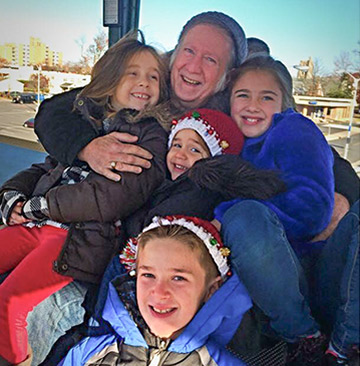
Great Uncle Tom with his grandnieces and grandnephew Lilly, Bella, Taylor, and Teddy
When Sharon Loshakoff invited him to play for an event at the Berkeley TM Center, it happened to be the tenth anniversary of Tom’s assault. “So I called it my ‘Whack on the Head 10th Anniversary Concert,’ with a picture of a Zen roshi or monk whacking a priest, to celebrate all the good that has come out of this potentially tragic experience—most recently and gratefully, learning TM,” writes Tom.
Tom has long wished to thank David Lynch and Bob Roth, CEO of the David Lynch Foundation, “for the life-altering gift they made available to me,” he says.“I could not have considered doing TM—or received the many benefits I have—if it weren’t for the scholarship I received. I am so grateful for having learned this practice, which has helped my healing as well as assisted with my spiritual progress, and now for having the opportunity to share this gratitude. Please make sure it’s always available for everyone, especially folks in need, as I was.”
“I am so grateful for having learned this practice, which has helped my healing as well as assisted with my spiritual progress.” —Tom Rudderow
Anjali Nayar, Multimedia Journalist
New York, New York
Anjali Nayar was at a crossroads. She had just graduated with honors from Columbia University Graduate School of Journalism, after being an award-winning animator and documentary filmmaker, but she was plagued by doubt and depression. While hunting for a job (and quitting smoking), she sought something to help and learned about the TM technique.

A still from Anjali Nayar’s animated short, Fishi-Ru (The Spirit of Fishi)
“I was looking for a way to tap into inner resources, to feel calm, to reconnect with my passion for writing from a place of love,” Anjali shares by email. “I was making a transition from working in the visual arts to becoming a print journalist and writer. While I was elated at this path opening up for me, I was really stressed and filled with uncertainty and self-doubt.”
Anjali was also suffering from the aftermath of a traumatic event years before, when she unwittingly witnessed a heinous crime. She reported it to the police and then had to testify in court. She sensed that learning TM would help her heal from this trauma.
Without a job, however, she couldn’t afford the TM course when she needed it most. But thanks to generous donations from local meditators to TMFriends.org, the New York City TM Center has a scholarship fund. “The TM grant helped me enormously,” she says. “Were it not for the grant I received, I might not have been able to begin.”
Anjali learned TM on October 21, 2017, with her TM teacher Kelly McKay. “I’ll always remember the date, because I consider it my special TM birthday,” she notes.
The effects were immediate and continuing. “I felt calmer and happier. Meditating grounded me and taught me to connect with myself,” she writes. “It showed me that my emotions and experiences were just that, and helped me to not let them define or control me. Practicing TM has opened a lot of doors for healing and self-discovery, allowing me to sense an inner stillness and light.”
“I felt calmer and happier. Meditating grounded me and taught me to connect with myself.” —Anjali Nayar
It’s easier to “choose healthier narratives for my own life story,” she finds—such as never smoking again. “Now I always begin my day with meditation. It’s a most dependable and dear friend.”
While redirecting her life narrative, Anjali took a brief break from her creative work. “When I reconnected, it happened naturally and positively. I felt able to come to my writing from a place of love,” she says.

Anjali Nayar is finding great success as a journalist and writer
In the year since Anjali began practicing the TM technique, she’s published five feature stories on subjects including glacial water harvesting and the healing effects of natural sounds, published a picture book for children, How Did the Kheer Go Missing?, and a short story for Scholastic India, and has more work on the way.
Ever grateful for the gift of TM, Anjali offered to volunteer at the TM Center. “I didn’t have money but I had time, and they needed help for a few hours on weekends. It worked out beautifully! I’d been looking for a way to contribute and help bring the practice of TM to more people, and I love working at the Center. Seeing the unceasing, dedicated efforts of all the teachers is heartwarming,” she writes.
Anjali concludes by reflecting on the vital role of TM scholarships: “People wishing to make a positive change in their lives come to the TM Center for an introductory talk. Sometimes they’re not in a position to afford the course fee. When they get the grant, their smiles and excitement reflect the promise TM makes for their lives, and I get the sense that their life will be different from here on. Just getting to witness this is like being in time for the perfect sunrise.”
“When [people] get the grant, their smiles and excitement reflect the promise TM makes for their lives, and I get the sense that their life will be different from here on.”
How to Give the Gift of Inner Peace
If you would like to help others like Cora, Tom, and Anjali change their futures and realize their dreams by learning the TM technique, make a tax-deductible contribution to TMFriends.org. You can direct your donation to your local TM Center or any of the TM organizations bringing the TM technique to people at risk. One-time or monthly donations of any amount, large or small, are welcome.
Your contribution will help bring the gift of inner peace to others when they need it most. Thank you, and Happy Holidays!
Editor’s Note: The effects of the TM technique, if any, on recovery after a traumatic brain injury or coma have not been scientifically established. However, a study of veterans with post traumatic stress and brain trauma, published in the journal Military Medicine, showed that “regular practice of Transcendental Meditation provides a habit of calming down and healing the brain,” said Dr. Vernon A. Barnes, a physiologist at the Georgia Prevention Institute at the Medical College of Georgia, Augusta University. Barnes, the study’s lead author, teaches the TM technique at the Dwight David Eisenhower Army Medical Center’s Traumatic Brain Injury Clinic at Fort Gordon, Georgia.
Disclaimer: Our intention is to provide general educational information. The information in this article is not intended to be personal medical advice, nor should it be used as a substitute for medical advice, diagnosis, or treatment.


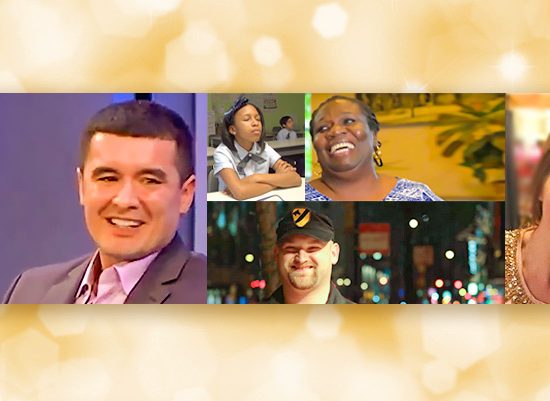
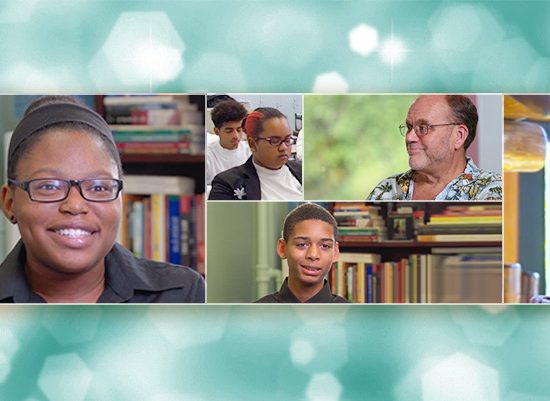
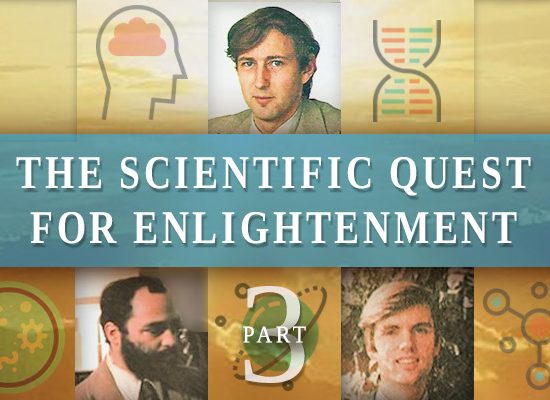

Since 1973